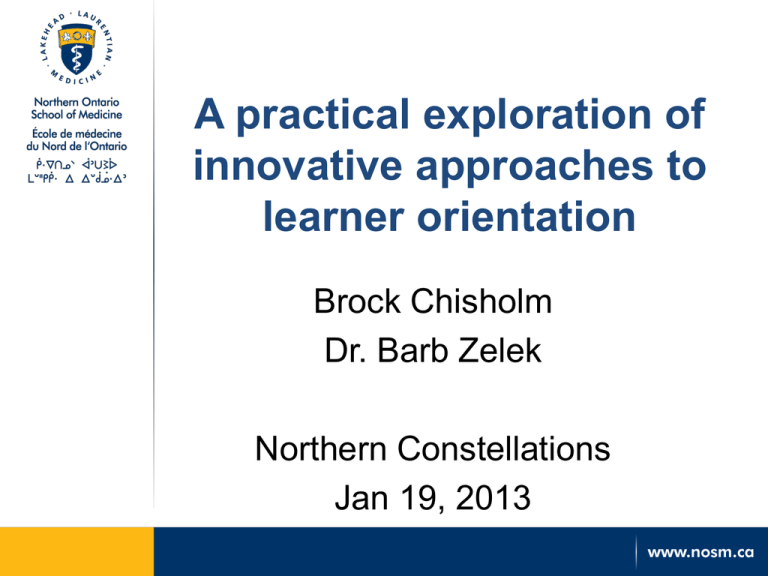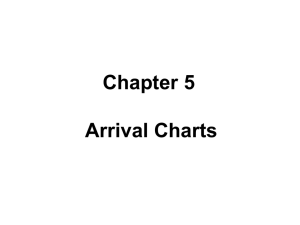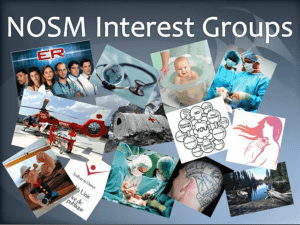Adult Learning
advertisement

A practical exploration of innovative approaches to learner orientation Brock Chisholm Dr. Barb Zelek Northern Constellations Jan 19, 2013 Conflict Disclosure Information: Presenter: Brock Chisholm and Dr. Barb Zelek Title of Presentation: A practical exploration of innovative approaches to learnerorientation. We have no financial or personal relationships to disclose. Your first task…. • Karibu KIPINDI YETU.Tunatarajia kufurahia, na kujifunza Mikakati baadhi nzuri ya inrikta wanafunzi wako! Objectives • 1. Review of adult learning styles. • 2. Gain an understanding of the role and importance of a successful learner orientation. • 3. Discover practical approaches to innovative learner orientation that can be adapted and developed for use in any facility using adult learning principles. Agenda • 1. Background – translation challenge - discussion – 5 minutes – Adult learning styles – video and discussion – 15 minutes • 2. How To Orient Learners – Determining Content – task and discussion – 15 minutes – Strategies / Models • Pre-arrival – 5 minutes • On Arrival – 10 minutes • Self-directed on–site - Scavenger hunt – 15 minutes – When and how - task and discussion -10 minutes – Evaluation/confirmation of learning – task and discussion 10 minutes • 3. Wrap up/Evaluation of Workshop – 5 minutes Principles of Adult Learning • http://www.youtube.com/watch?v= Cu_PpkqWJGA&feature=related • Malcolm Knowles 6 characteristics Adult Learning Principles • Autonomy • Life Experience • Goal Oriented • Relevant • Practical • Respect Adult Learning – why? • Benefits reported from adult learning approach : – Clearly defined structure aids in reducing anxiety. – Active involvement results in more effective learning of initial information. – Self-direction enables feelings of mastery and competence. – Models the approach to self-directed clinical practice. (Rauch) Orientation = Adult Learning Adult Learning – How? Rauch– orientation strategy based on adult learning principles 5 assumptions – 1. Orientation is a process that takes place over time. – 2. Students are adults capable of self-directed learning. – 3. Instructor’s role is to enable learning. – 4. Active learning better than passive learning. – 5. Written objectives guide learning and facilitate evaluation. (Rauch) Adult Learning – How? • • • • • Treating people as adults-an approach to teaching: Respect-Mutual, establish immediately Research-Today’s students are evidence-based, so must you be Responsiveness-Assimilate their learning goals/styles with what they must learn Reciprocity-Communication is the key (Brookfield, 1999) Adult Learning = Limitless Opportunities for Orientation How To Orient Learners Orientation topic defined, and principles of adult learning applied to each topic. 1. Define the content of the orientation: what the student will learn and know about the topic. 2. Determine the orientation strategy/model. - self-instructional requiring independent planning and problem- solving. 3. Confirm the learning/EvaluationDid the student learn the required the content of the orientation. (Rauch) Orientation Content – What and Why • In small groups, spend 5 minutes developing a list of what needs to be covered in an orientation • Use the checklist, and just complete the first 2 columns • What • Why – Must know (for safety and security) – Need to know (to be effective) – Nice to know (to be comfortable) Orientation Content - example • Refer to handout Appendix 2 Orientation Delivery – When • • • Pre-arrival On arrival Ongoing Orientation Delivery Models - Prearrival • Email/letter • Online – webpage link – http://mfht.org/?page_id=46 – http://mfht.org/?page_id=48 • Learner program to provide relevant learner information • • • • • • • • • • • • • • • • • • • • Dear Learner(name) Thank you for requesting your placement at the Lake of the Woods District Hospital Rehabilitation Department. The physiotherapy staff and I look forward to providing you with a positive and enjoyable learning experience. Following are some answers to frequently asked questions regarding placement in our facility: Hours of operation – The Rehab department is open 8-4, with a one hour lunch break from 12-1, Monday to Friday excluding stat holidays. First Day – Report to Rehab department, which is on the main floor of the hospital at 8:00 a.m., at which time you will be given an orientation to the facility and your specific placement. Parking – If you are driving your own vehicle, you will be provided with a parking pass for a refundable $10.00 deposit, which will allow you to park for the duration of your placement in the VISITOR parking lot for free. Accommodation – If you have not already arranged for your accommodations, please contact your clinical co-ordinator to ensure that you have been allocated an apartment, through NOSM. These apartments are within a 30 second walk of the hospital, and are fully equipped with all amenities. Dress Code – Maroon pants with maroon vests, and pink shirts are required. Books – The Rehabilitation Department is fairly well supplied with resource materials for all patient care areas. As well, a PC is available for student use, with internet access. Please be aware that Hotmail is not accessible through our hospital due to Virus concerns. Community events – Kenora is situatated on beautiful Lake of the Woods, which offers an abundance of seasonal recreational opportunities, in addition to having a diverse and enjoyable cultural milieu. For more information go to either www.mykenora.com and click on community profiles. Flu Shots – Flu shots are not mandatory, but in the event that a flu outbreak occurs and an order is received from the health unit, only immunized staff will be allowed. This could put your placement at risk if you are not immunized. P.S. Just kidding about the dress code, you can wear any professional dress clothes, as long as there are no blue jeans or T-shirts with printed messages. Please avoid dangling jewelry, no strong perfumes or scents. Footwear policy is enforced, and must have closed non-permeable toe (ie leather upper; mesh runners not allowed) for your own safety in the event of a spill or dropped sharp. Should you have any further questions, comments or concerns, please call me at 807-468-9861 ext 214, or email me at mailto:bchisholm@lwdh.on.ca. Thank you, Brock Chisholm, B.Sc.-P.T., Manager of Rehabilitation, LWDH Orientation Delivery Models – prearrival learner information • Refer to handout Appendix 3 Orientation Delivery Models – Social Media (pre or on arrival) • Twitter – orientation hashtag • Facebook • Texting • Apps • Blogs • Orientation video link More Orientation Delivery Model – on arrival • • • • Hard copy/binder One on one with preceptor One on one with support staff Other examples of self directed orientation strategies Orientation Delivery Model – on arrival • Block out time on first day • Self-directed on–site Scavenger hunt can be effective time saver Lets put our heads together… Learner Orientation – When and How • In small groups, spend 5 minutes adding to your list of what needs to be covered in an orientation • Use the checklist, and just complete the 3rd and 4th columns • When – Prearrival – On arrival – ongoing • How Orientation Evaluation and Confirmation • In small groups, spend 5 minutes adding to your list of what needs to be covered in an orientation • Use the checklist, and just complete the 5th column • How the learning is confirmed Memorandum of Understanding • Include need to know stuff • Quiz http://www.stjoes .ca/media/Learn erOrientQuiz.pdf • Signed MOU Further learning • Links to education sites – http://www.preceptor.ca – http://www.practiceeducation.ca/ Summary • Reviewed adult learning principles • Need to know vs. good to know content for learner orientation • Various models for delivering content both before and on arrival of learner • Confirmation of learner understanding of content Next Steps – Imparting Your Knowledge… Questions • Brock Chisholm – bchisholm@nosm.ca • Barb Zelek – bzelek@mfht.org








